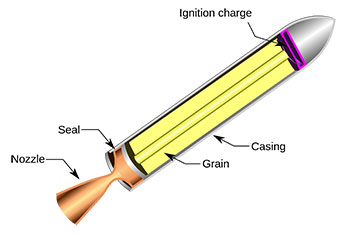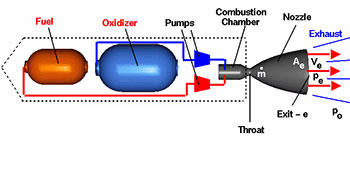Rockets were first used by the Chinese in 1232 A.D. At this time, the Chinese and Mongols were at war. During the battle of Kai-Keng, the Chinese shot a barrage of arrows to repel the Mongols assault.
How a rocket works? It burns fuels and turn them into hot gas. The rush of hot gas from the rear propel the rocket forward. Every action there is an equal and opposite reaction which is Newton's Third Law of motion. A jet engine requires air to work but rocket doesn't. It carries it's own fuel and oxygen. It's fuel can be in solid or liquid form.
For a solid fuel rocket, the fuel and oxidizer are mixed in to a solid propellant packed into a cylinder. To start a rocket burning an igniter is lighted at the end of the propellant and hot gas would gush out from the nozzle. Thus, pushing the rocket forward. For a basic solid propellant rocket, once ignited it cannot be shut off. As for a more advance rocket, the adjusting the speed, extinguishing and re-igniting can be done by controlling the nozzle geometry and vents ports. Up to date designs have steerable nozzle, avonics, altitude control motors, auxiliary power unit (APU), recovery hardware (parachutes) and etc.
In a liquid propellant rocket, the fuel and oxidizer are separately stored. The fuel and oxidizer are pumped into the combustion chamber of the nozzle where they are burned. Thus, producing hot gas thrusting out from the rocket, hurling the rocket forward. This rocket can be monopropellant, a single type of propellant, bipropellant, two types of propellant, tripropellant, three types of propellant. Some of these rockets are throttleable and can be stopped and reignitable.
Hybrid rockets are solid fuel and liquid oxidizer combined into one. (Credit:comsol.com)





